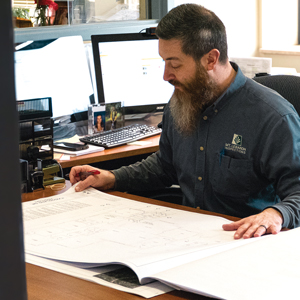permits are easy; variances are hard
Who needs a building permit? Pretty much everyone who is planning to swing a hammer or run a saw. You need them for decks, pools, parking pads, fences, sheds and lots more. Although we generically refer to them as “building permits,” some, such as permits for sheds, fences and driveway replacement and expansions, actually are zoning permits. Last year, the Inspection Office issued 536 permits.

You (or your contractor) can pick up and drop off permit applications at Mt. Lebanon’s Customer Service Center, 710 Washington Road, or download them from the municipal Web site, www.mtlebanon.org.
Once you get your permit, display it prominently in the window so it is visible from the street. It’s a good idea to place it where it’s visible to whoever might have concerns about the project (your nosiest neighbor). You also should keep copies of the approved plans on site.
If your construction project requires the use of a Dumpster, placing one on the street requires a permit; please call the police traffic division at 412-343-4086 for details.
Generally, when you hire a contractor to do work, he will be familiar enough with the building codes to know when to talk with inspectors and apply for a permit. Still, keep in mind that any irregularities with the permit are the homeowner’s responsibility, and could delay the progress of your project or even require you to redo something that has not been done according to code.
Whatever you have in mind for your property, it’s a good idea to make an appointment with Chief Inspector Joe Berkley, who will review your plans and let you know if what you want to do is in line with Mt. Lebanon’s zoning ordinance.
“Five minutes with me can save you a lot of headaches,” Berkley says. “If there’s something you want to do that’s not permitted under the ordinance, most times I can suggest an alternative.”
If a short meeting with Berkley doesn’t yield any solutions you can live with, your next step is to apply to Mt. Lebanon’s Zoning Hearing Board for a variance, which is an exception to the ordinance.
The zoning code is pretty specific about what you can or can’t do in every zone—single family residential, multifamily residential, commercial, mixed-use. Code exemptions are granted on a case-by-case basis, but receiving one can be very difficult. Cost of filing an application for variance is $175 for residential properties of up to four units, and $700 for all other cases. The board typically will make a final decision the night of the hearing. For denials, the board must issue the findings of fact within 45 days of the hearing. In 2015, the board heard 20 appeals. Twelve were granted, four were denied, one was continued and three were dismissed.
In order to receive a variance, an applicant must prove that a hardship exists in the present condition—one that cannot be remedied. There are five conditions an applicant has to meet in order to receive the variance:
- There must be unique physical circumstances peculiar to the property, such as a steep hill next to the house or a house on an irregularly shaped lot.
- There must be no way possible to develop the property in conformity with the ordinance.
- The unnecessary hardship cannot be one created by the applicant. For example, if you built a shed in your backyard and now you don’t have room for a pool, you will not receive approval.
- The variance cannot alter the character of the neighborhood, impair the use or development of adjacent property or be detrimental to public welfare.If granted, the variance must be done with the least modification to the zoning ordinance.
The zoning hearing board, composed of three members, is a quasi-judicial board, which means that although the formal rules of evidence that govern judicial proceedings may not apply, the board is empowered to render legal decisions in a narrowly defined field of expertise, and the records of the hearings are considered to be legal records.

If you decide to go before the zoning hearing board, the best advice Berkley can give is to do your homework. The board meets every 28 days; the schedule is set a year in advance, and applications must be submitted at least 30 days before the meeting, to allow time for proper notification to surrounding properties. Four plot plans or surveys and four sets of drawings of the structure are required. A recent applicant submitted a 17-page presentation, quoting the applicable section of the ordinance that he was appealing, and outlining point by point each of the five conditions he needed to satisfy, with photos, maps and drawing to illustrate each point.
If an applicant makes a valid case, the board can grant a variance, with or without conditions. If the board denies the variance, the applicant’s next step is to appeal the decision in the Court of Common Pleas within 30 days of receiving notification of the board’s decision.
Of course, as previously noted, you can potentially save yourself a lot of expense and aggravation by taking advantage of Berkley’s expertise. After more than two decades of working here, he’s seen just about everything. “You may not always get the answer you want,” says Public Information Officer Susan Morgans, who has put three additions on her home over the past 30 years. “But Joe is helpful, and the municipal staff recognizes him as being knowledgeable, consistent and fair.” To schedule an appointment with the inspection office, call 412-343-3408. More information about building permits, variances and the zoning hearing board can be found on the inspection office’s section of the Mt. Lebanon website.





